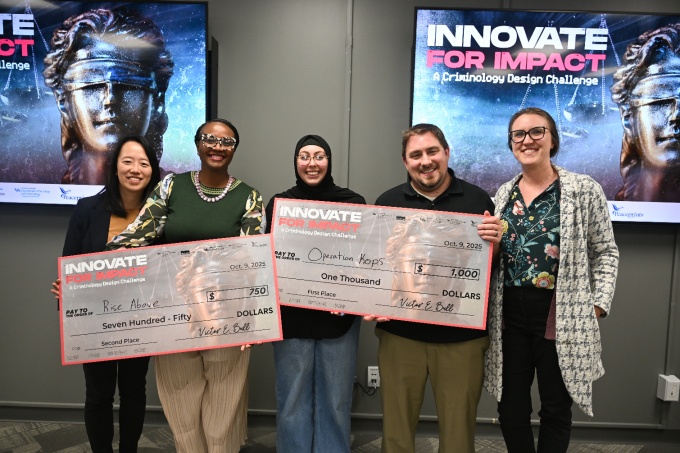Campus news
Students take on justice reform in new criminology design challenge

The Criminology Design Challenge invited student teams to design new programs, technologies or interventions to address some of society’s most pressing criminal justice and public safety issues. The challenge awarded cash prizes to the top three teams. Photo: Nancy J. Parisi
By CAS STAFF
Published November 19, 2025
In a first-of-its-kind competition, UB students showcased their creativity, collaboration and compassion during the Innovate for Impact Criminology Design Challenge — a two-week innovation sprint focused on reimagining justice, safety and community well-being.
Hosted by UB’s Startup & Innovation Collaboratory and in partnership with the Department of Sociology and Criminology and the Office of Student Engagement and School of Law, the contest invited student teams to design new programs, technologies or interventions to address some of society’s most pressing criminal justice and public safety issues. Topics ranged from youth violence and reentry to restorative justice, community-police relations, and digital crime.
“This challenge gave students the chance to develop tangible solutions with real-world impact while thinking critically about justice, equity and community engagement,” said Hadar Borden, Director of UB’s Startup & Innovation Collaboratory. “It’s inspiring to see how students combine data, empathy and creativity to tackle complex social problems.”
Students gained guidance from professionals across the region, including representatives from UB’s School of Law, as well as from Peaceprints of WNY (an organization offering comprehensive reentry services to men and women involved in the criminal justice system), before presenting their projects at the Oct. 9 finale held in the UB Startup and Innovation Collaboratory office in Student Union 340. There, students pitched to a panel of community and campus partners and demonstrated their understanding of criminological theory, ethical practice, and practical innovation. The judging criteria included viability, social entrepreneurship, equity and empathy, and ingenuity.
“The Criminology Design Challenge gives students a powerful opportunity to learn about how to turn their classroom learning into real-world solutions,” added Yunmei (Iris) Lu, assistant professor and Director of Criminology MS Program. “Particularly, students in the challenge engage with scholars and community leaders who provide valuable guidance and feedback on their ideas, helping them refine their plans into clear, actionable proposals.”
Students said the experience gave them new insight into how data, community partnerships and social innovation intersect in the field of criminology.
“Success is not where you’ll find your ultimate passion,” said Iesha Aughtry, MS Criminology, “it’s in failure that you’ll see the path that was written for you.”
Top honors go to Operation K.O.P.S
The challenge awarded cash prizes to the top three teams — $1,000 for first place, $750 for second, and $500 for third — and provided all participants with valuable experience in social impact design and collaborative problem-solving.
· The first-place team, Operation K.O.P.S (Kids & Officers Partnering Safely), designed a community initiative to strengthen relationships between youth and law enforcement through mentorship and shared activities that foster trust and understanding. Students: Nour Jaber (MS Criminology) and Chris Bragg (MS Criminology).
- Second place went to Rise Above, which focused on reducing youth violence through early intervention and restorative justice education. Students: Iesha Aughtry (MS Criminology) and Adam Carlson (MS Criminology).
- What Are You Doing? earned third place for developing a reusable, portable police car mock-up to deter speeders. Students: Wonwook Lee (BS Business Administration), Jeonghoon Shin (BS Business Administration), Ethan Choi (MBA).
The Criminology Design Challenge was led by Andrew Lavoie, design challenge coordinator for the Startup & Innovation Collaboratory, and supported by faculty and staff collaborators including Yunmei Lu, Ashley Barr, Christine Bartholomew, Cindi McEachon, Austin Waters, Rebecca Chapman, and Rachel Di Domizio.
“Our students showed that innovation and justice are deeply connected,” said Lavoie. “This is exactly what the Startup & Innovation Collaboratory was built for — giving students the opportunity to turn ideas into meaningful action. By also connecting our students to community experts, it has expanded their networks and allowed them to have a better understanding of these real-world issues. When they’re invited to design for impact, they don’t just meet the moment — they redefine it.”